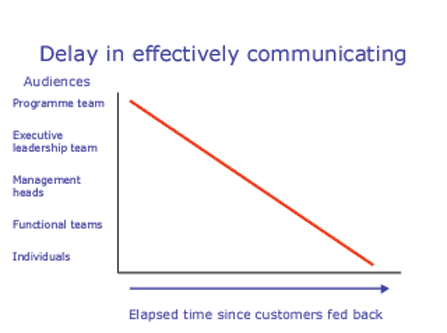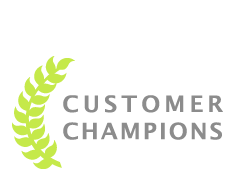Engaging employees with customers
Effective internal communications
Assuming that essentials for any customer satisfaction programme are in place, such as active management support, a key element of success is ensuring that individual employees at all levels engage with the results. Employee engagement comes in the form of recognising what they can do individually to improve the customers’ experience and to achieve this effective internal communication is essential. Employee engagement is about ensuring employees understand customers, securing employee buy in to customers and imbuing a sense of employees owning customer feedback.
There are many and varied internal communication tools open to most organisations, however the vast majority of them tend to be focused on making people aware of the results, not acting upon them. The table below lists typical groups of employees, and examples of the usual tools applied to communication.
| Audiences | Content | Standard communication tools |
|---|---|---|
| Customer satisfaction programme team | Detailed results |
|
| Executive management team | Overview of results |
|
| Managerial heads | Summary of key findings |
|
| Functional teams | Summary of key findings plus function specific findings in greater detail |
|
| Individuals | Summary of key findings plus function specific findings in greater detail plus specifics to their role |
|
- The detail just isn’t provided to the employees that can make the greatest difference for customers, in that they deal with them frequently and are therefore able to interpret the customer feedback for themselves. The consequence is that the level of employee buy in to customers is compromised at best, minimal at worst.The traditional top down managerial structure in relation to the customer creates many barriers to the effectiveness of communication, and therefore acting on customer feedback. By placing the customer at the centre of the organisation this would allow for the flow of customer feedback to both the Executive team and customer facing employees in the same timescale. This would mean that action plans can be developed in outline by the employees who have the greatest degree of customer exposure and a sense of employees owning customer feedback is achieved and there is employee customer engagement.
These action plans can be passed around the organisation for further development and when required, approval. At the same time general findings and management direction are flowing down from executive management to all employees.
- There can be a significant time delay from gathering the customer feedback to employees hearing what they have said. Although this does vary by organisation, Customer Champions’ experience is that it can easily be months before individual employees hear anything, let alone act upon it, something that can only result in employee buy-in to customers being damaged. The chart below shows the typical audiences the information would pass through.

- The presentation format is typically a one-way communication, and so the ability for employees to own customer feedback and to act upon it is restricted. As a by-product, we have also found that with the demise of good old fashioned reporting in favour of PowerPoint, much of the information required for giving longevity to results and seeing long-term employee customer engagement is lost.
So in summary traditional communication structures result in feedback being delayed, potentially incorrectly analysed, and not owned by the most effective group of employees. Not a strong foundation on which to develop an improved customer experience delivered by a committed team of employees who understand customers!
Workshops – the most effective tool for communication and acting upon customer feedback
Although reviewing and updating the most effective methods of internal communications will improve the dissemination of information, the ultimate aim is to act upon it. Customer Champions have found that the most effective tool to gaining employee buy-in to customers is to encourage two-way communication through the deployment of workshops. The primary focus of this tool is to enhance communication by focusing on the development and ownership of an effective action plan. The more focused these workshops are on ensuring employee customer engagement the more likely they are to deliver success.
The ten key steps that Customer Champions apply to a successful employee customer engagement workshop are:
- Ensure that the subject and audience is tightly targeted. Issues that are too wide are likely to create a lot of discussion, but not a lot of action. Define a clear statement of the problem that is to be tackled and what the objective for the output of the session is. In our broad experience, less is most definitely more in terms of attendees.
- Check that attendees are empowered to not only make decisions on the day of the workshop, but empowered to act upon the workshop’s output.
- Provide a pre-briefing to all attendees. This includes the issuing of pre-reading material, which may well need them to do some further research to identify potential root causes. As a minimum, attendees should be encouraged to bring additional, potentially valuable, data with them to the workshop. This means they ‘hit the workshop running’.
- Use ice breakers if the group don’t know each other as there is likely to be a mixture of views and you need to make sure everyone is comfortable to talk.
- Make the session interactive and provide regular breaks which could be through a series of different tasks (think about whether a physical or mental exercise would be most productive).
- Encourage people to brainstorm, but provide them with rules of engagement, and agree how their thoughts are going to be captured.
- Use an external facilitator to ensure that all views are captured and outcomes are not predetermined or prejudged.
- Manage the time effectively so that the crucial desired output from the session has enough time allocated to it. Too often the most vital work at the end of a workshop is hurried due to poor timekeeping.
- Produce an agreed action plan, which must contain clear actions, who is responsible for them, and the target date. Ask people to physically sign the action plan as a notional commitment to its success.
- Identify who is responsible for the communication of the actions and what are the key messages to be issued to which audiences, both internally and externally.
Even following these steps will not guarantee successful action and employees owning customer feedback. We have all been to workshops that, on the day, have been run well and have delivered the desired action plan. However, nothing seems to change, commonly because the day job takes over and the spotlight moves elsewhere. Even with a structured approach Customer Champions research shows that only 1 in 3 of these action plans gets fully implemented, and so the benefit to the customer is not maximised.
Converting words into action
In order for the output of a customer focussed workshop to deliver effective results and employee customer engagement the following need to be in place:
- An agreed follow up structure to ensure the action plans have been delivered and, if not, to understand what barriers may be in place, and how these can be overcome.
- An agreed single measurement to track the impact of the actions upon the customer (and the business if appropriate). This could be a combination of a metric collected from customers and internal based data.
- Recognition of the importance of the work. If the workshop attendees perceive the agreed action to be “additional to their day job” the actions will not get the priority that they require. This may require a review of an individual’s job description and objectives.
- A structure that ensures that actions taken are implemented into processes to ensure the new activities / approaches become the standard way of doing business.
Case Study – developing effective customer service processes
Client problem
A) Customer enquiries were handled through a combination of a centralised contact centre and a series of UK-wide area offices. The perceived standard of service received by customers could vary significantly depending upon where they entered the organisation. The objective was to raise the standards no matter where or how the customer made contact.
B) It was believed that if a series of standard rules and regulations were implemented there would be no ownership of the associated actions at a local level.
Customer Champions’ approach
The objective of each workshop was to develop an effective action plan that could be owned and implemented by the attendees.
A template was developed to run a series of area specific workshops across the organisation. The focus was to ensure that the customer facing team developed what they determined were the appropriate actions required to improve their customers’ experience and their own working procedures.
Before each workshop a series of interviews with customers and colleagues were conducted to understand the perceived level of service currently being provided.
Each workshop covered a variety of exercises to:
- enable attendees to think of themselves as a customer
- understand the customer feedback as well as related feedback from colleagues
- map the processes and identify barriers and failure demand
- put an improvement action plan into place
Follow-up sessions were then executed to:
- ensure successes were recognised
- highlight and remove barriers
- put measurements in place
Client Testimonial
“Customer Champions have provided high quality facilitation skills in helping the Environment Agency roll out a nationwide series of Customer Service workshops. Their experience ensured that employees attending the workshops were able to contribute to, develop, and commit to their own action plans to ultimately deliver high levels of customer service.”
Head of Customer Relations
Take the next step
To discuss how to convert customer feedback into employee engagement in relation to your company, get in touch with Customer Champions.

